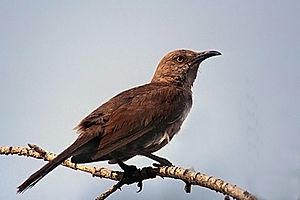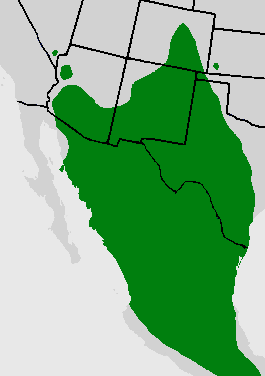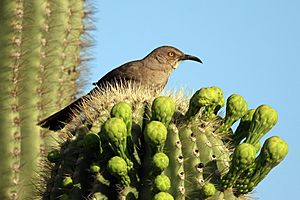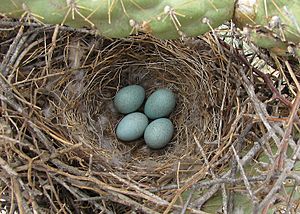Curve-billed thrasher facts for kids
Quick facts for kids Curve-billed thrasher |
|
|---|---|
 |
|
| Conservation status | |
| Scientific classification | |
| Genus: |
Toxostoma
|
| Species: |
curvirostre
|
 |
|
The curve-billed thrasher (Toxostoma curvirostre) is a medium-sized bird. It lives in the deserts of the southwestern United States and much of Mexico. This bird does not migrate, meaning it stays in the same area all year. It is often the most common thrasher in these desert regions.
The curve-billed thrasher is mostly grey-brown. It has a bill that curves slightly, like a sickle. It looks a bit like its relative, the Bendire's thrasher. These birds usually live in deserts. However, they can also live in areas where many humans are present.
Even though it can be a bit shy, the curve-billed thrasher often lets people watch it closely. It is very protective of its food and babies. It will chase away other birds or animals that seem like a danger. The curve-billed thrasher can copy the songs of other birds. It has many different songs. Because it sings so many different songs, people in Mexico call it cuitlacoche, which means 'songbird'.
Contents
About the Curve-billed Thrasher
The curve-billed thrasher was first described in 1827 by William Swainson. Scientists have identified several different types, or subspecies, of this bird. These subspecies are grouped into two main branches: Eastern and Western.
Scientists believe the curve-billed thrasher is closely related to other thrashers. These include the ocellated thrasher, brown thrasher, long-billed thrasher, and Cozumel thrasher.
Different Types of Curve-billed Thrashers
There are several known subspecies of the curve-billed thrasher.
Eastern Types:
- T. c. oberholseri (Law, 1928) – Also called the Brownsville thrasher. It lives from southeastern Texas to northeastern Mexico.
- T. c. curvirostre (Swainson, 1827) – This type lives in Central to South-Central Mexico.
- T. c. celsum (R. T. Moore, 1941) – Known as the plateau thrasher. Its range goes from southeastern Colorado and southwestern Kansas to southern Arizona and northern Mexico.
Western Types:
- T. c. insularum (van Rossem, 1930) – Called the San Esteban thrasher. It lives on islands like San Esteban and Tiburón in the Gulf of California.
- T. c. maculatum (Nelson, 1900) – The spotted thrasher. Found in northwestern Mexico.
- T. c. occidentale (Ridgway, 1882) – The Mazatlan thrasher. It lives in Western Mexico.
- T. c. palmeri (Coues, 1872) – Known as Palmer's thrasher. It lives in southern Arizona and northern Mexico. This type is quite different and some scientists think it might be its own species.
What the Curve-billed Thrasher Looks Like
You can easily tell a curve-billed thrasher by its long tail and short wings. Its bill is shaped like a sickle and is brownish-black. The bill is almost as long as its head is wide. This bird has a compact body with a large head. Its chest is grayish-brown with round, brown-gray spots. Its eyes are usually orange, turning golden as the bird gets older. Young birds have slightly different feather colors.
The different subspecies have noticeable differences. Eastern types have clearer spots on their chest and more white on their tail feathers. T.c. palmeri has fewer spots and less clear wing bars. For example, T.c. curvirostre has longer wings and tail than T.c. oberholseri.
Measurements:
- Length: 10.6-11.0 inches (27-28 cm)
- Weight: 2.1-3.3 ounces (60.8-93.6 g)
- Wingspan: 13.4-13.6 inches (34-34.5 cm)
Voice and Song
The most unique sound of the curve-billed thrasher is a sharp whit-wheet. It sounds like someone whistling to get your attention. They usually make this sound from high places. Their songs are similar to a northern mockingbird's, but they sound more pleasant. A thrasher can sing for 2 to 15 seconds, repeating phrases two or three times. They have a large vocabulary of sounds. This allows them to create many different songs.
Like other mimids, it can copy the calls of several other bird species. These include the scissor-tailed flycatcher and the northern cardinal.
Similar Birds
The curve-billed thrasher is often confused with the Bendire's thrasher because they look similar. Here are some ways to tell them apart:
- The curve-billed thrasher has an all-black bill. The Bendire's thrasher has a paler lower bill.
- The curve-billed has both the top and bottom parts of its bill curved. The Bendire's thrasher has a curved top bill but a mostly straight bottom bill.
- Curve-billed thrashers usually have larger, rounder spots on their chest. Bendire's thrashers have smaller, more pointed markings.
- Curve-billed eyes are typically orange. Bendire's eyes are usually yellow.
- The curve-billed thrasher is heavier. It is also more likely to live in suburban areas. Bendire's thrashers prefer open grasslands.
- The Bendire's song is more melodic. The curve-billed is known for its whit-wheet calls.
These differences are even clearer when looking at young birds of both species.
Where Curve-billed Thrashers Live

The curve-billed thrasher is common in the southwestern United States. This includes Arizona, New Mexico, west Texas, southeastern Colorado, and southwestern Kansas. It also lives in most of Mexico. Sometimes, these birds wander to other states. They have been seen as far north as North Dakota and as far east as Florida.
Compared to other desert thrashers, the curve-billed thrasher is not very picky about where it lives. It can be found from ground level up to 3,000 meters (9,800 feet) high. It usually lives where plants like cholla and saguaro cacti, ocotillo, mesquite, and creosote bushes grow. They can also live near woodlands or in dry desert areas with cacti. If there are enough desert plants near human homes, along with bird feeders, the curve-billed thrasher can adapt well.
Behavior and Life in the Wild
The curve-billed thrasher often runs quickly from one hiding spot to another. It also flies low from bush to bush. However, this bird is not afraid to be out in the open. It usually looks for food on the ground. It can be very aggressive when other birds or animals try to get food from feeders.
Reproduction and Nests
The breeding season for curve-billed thrashers starts in February. It is busiest between March and May. However, young birds have been seen as late as August. The exact timing depends on the temperature and rainfall in their area.
Nests are usually built in easy-to-see places. Cholla cacti are a favorite spot. Other places include mesquite, prickly pear, or yucca plants. Sometimes, they even build nests in oak or pine trees. The nest is usually a deep cup shape. The outside is made of thorny twigs. The inside has smooth sticks, roots, and soft grasses.
Both the male and female bird help build the nest. This can take from three days to four weeks. The number of eggs varies, from two to five. The eggs can be bluish-green or pale yellowish-blue. They have many reddish-brown spots. Both parents help keep the eggs warm, but the female does most of the work. Curve-billed parents strongly defend their nests from other animals. Snakes are common predators of eggs and baby birds. It is rare for cowbirds to lay their eggs in a thrasher's nest. If food is scarce, parents feed the older baby birds first. The young birds leave the nest when they are 11 to 18 days old.
What Curve-billed Thrashers Eat
The curve-billed thrasher eats both plants and animals. Its diet includes insects like beetles, moths, butterflies, spiders, and snails. It also eats fruits from cacti, prickly pear, and other plants. These birds have even been seen eating dog food and feeding it to their chicks.
They mostly find food on the ground. They are not very good at climbing on branches. Thrashers will pick up food from the surface. They will also dig holes up to 2 inches (5 cm) deep to search for food. Curve-billed thrashers also sip nectar from saguaro blossoms. They eat insects trapped inside the flowers. This helps pollinate the saguaro plants. They also love saguaro fruits, which give them important water during dry months.
Dangers to Thrashers
Snakes, coyotes, and roadrunners are predators that mainly hunt young birds. This might be why only about 20% of nests are successful each year.
Curve-billed thrashers and cactus wrens often live in the same areas. They also like to build nests in the same type of cactus, the jumping cholla. Because of this, they often have conflicts. Fights over food are rare. However, fights to protect their young are very intense. They will try to destroy each other's nests, especially roosting nests (where they sleep), but usually not breeding nests. Despite these fights, curve-billed thrashers and cactus wrens can sometimes successfully raise their young very close to each other. During breeding season, both species strongly defend their own nests. After the breeding season, when young birds have left the nest, the competition becomes more fierce.
Conservation Status
The curve-billed thrasher is listed as a species of least concern by the International Union for the Conservation of Nature. This means it is not currently in danger of extinction. However, its population is slowly decreasing.
See also
In Spanish: Cuitlacoche piquicurvo para niños






